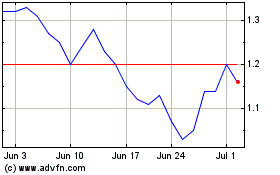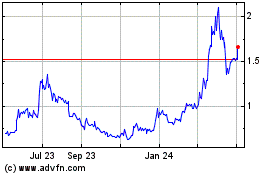Atossa Therapeutics, Inc. (Nasdaq: ATOS) (“Atossa” or the
“Company”) today announced promising safety and efficacy data from
the Company’s Phase 2 EVANGELINE (Endoxifen Versus exemestANe
GosEreLIn) clinical trial. The EVANGELINE study is evaluating
(Z)-endoxifen as a neoadjuvant treatment for pre-menopausal women
with Grade 1 or 2 Estrogen Receptor positive (ER+) / Human
Epidermal Growth Factor Receptor 2 negative (HER2-) breast cancer.
Atossa is a clinical stage biopharmaceutical company developing
innovative medicines in areas of significant unmet medical need in
oncology with a focus on breast cancer.
The data, which is being presented at the American Association
for Cancer Research (AACR) Annual Meeting, is from the 40mg
pharmacokinetic (PK) run-in cohort of the study. Seven women were
enrolled in the cohort and treated daily for 28 days. At 28 days,
six of the seven had Ki-67 levels below 10% and stayed on treatment
for an additional five months. Per the study protocol, the seventh
patient, whose Ki-67 decreased 19% but stayed above 10%,
discontinued treatment and had surgery.
Among the six patients who were treated for a total of 24-weeks,
magnetic resonance imaging (MRI) central review demonstrated target
lesion decreases in all patients with one complete response (CR),
one partial response (PR) and four stable disease (SD), per
Response Evaluation Criteria In Solid Tumors (RECIST) criteria. The
average target lesion decrease was 32% at 12 weeks and 37% at 24
weeks with all patients experiencing at least a 15% reduction in
target lesion at 24-weeks.
Ki-67 for the 40mg cohort patients was reduced from an average
of 14.5% at screening to 5.3% at 28 days and 1.2% at 24-weeks. This
represents a reduction of 63% at 28 days and 92% at 24 weeks. Ki-67
is a cellular marker for proliferation and indicates how fast the
tumor is growing. Less than 10% is considered low and associated
with better surgical outcomes and a lower incidence of
recurrence.
Treatment related toxicities included grade 3 headache (one
patient), grade 2 amenorrhea (one patient), and grade 2 hot flashes
(one patient). There were no grade 4 or 5 treatment related
toxicities.
"The EVANGELINE study introduces a promising neoadjuvant
approach for premenopausal women with ER+/HER2- breast cancer,
exploring a potential treatment option that could improve clinical
outcomes without the need for ovarian function suppression,” said
Nusayba A. Bagegni, MD, Associate Professor of Medicine, Division
of Oncology, Washington University School of Medicine and
EVANGELINE study investigator. “The data thus far, which shows
(Z)-endoxifen is beneficial and well tolerated, suggests that this
treatment could potentially help address a significant unmet need
in this patient population.”
“The 40mg EVANGELINE data is extremely encouraging as it shows
that (Z)-endoxifen can not only stop ER+ breast cancer from
growing, but it can also shrink or eliminate the tumor, as measured
by MRI imaging,” said Dr. Steven Quay, Atossa’s President and Chief
Executive Officer. “The depth of response at 40mg may even improve
in the next phase of the study where we are now treating women with
80mg of (Z)-endoxifen daily. We expect this dose to deliver the
optimal steady-state plasma concentrations required to fully target
PKCβ1 inhibition and further enhance (Z)-endoxifen’s antitumor
efficacy.”
About (Z)-Endoxifen(Z)-endoxifen is the most
potent Selective Estrogen Receptor Modulator (SERM) for estrogen
receptor inhibition and also causes estrogen receptor degradation.
It has also been shown to have efficacy in the setting of patients
with tumor resistance to other hormonal treatments. In addition to
its potent anti-estrogen effects, (Z)-endoxifen has been shown to
target PKCβ1, a known oncogenic protein, at clinically attainable
blood concentrations. Finally, (Z)-endoxifen appears to deliver
similar or even greater bone agonistic effects while resulting in
little or no endometrial proliferative effects compared with
standard treatments, like tamoxifen.
Atossa is developing a proprietary oral formulation of
(Z)-endoxifen that does not require liver metabolism to achieve
therapeutic concentrations and is encapsulated to bypass the
stomach, as acidic conditions in the stomach convert a significant
proportion of (Z)-endoxifen to the inactive (E)-endoxifen. Atossa’s
(Z)-endoxifen has been shown to be well tolerated in Phase 1
studies and in a small Phase 2 study of women with breast cancer.
(Z)-endoxifen is currently being studied in four Phase 2 trials:
one in healthy women with measurable breast density, one in women
diagnosed with ductal carcinoma in situ, and two other studies
including the EVANGELINE study in women with ER+/HER2- breast
cancer. Atossa’s (Z)-endoxifen is protected by three issued U.S.
patents and numerous pending patent applications.
About Premenopausal Patients with ER+ / HER2- Breast
CancerBreast cancer is the most frequently diagnosed
cancer in premenopausal women worldwide and accounts for almost
half of the cancers that occur in women aged 15-49. An overwhelming
majority (75%) of premenopausal breast cancer is estrogen receptor
positive (ER+). Ovarian function suppression (OFS), when combined
with either tamoxifen or an aromatase inhibitor, is the current
standard of care for the endocrine management of stage 2 and 3
premenopausal ER+/HER2- breast cancer.
About EVANGELINEPhase 2 EVANGELINE (Endoxifen
Versus exemestANe GosEreLIn) study is investigating Atossa’s
patented (Z)-endoxifen as a possible neoadjuvant treatment for
pre-menopausal women with Grade 1 or 2 Estrogen Receptor positive
(ER+) / Human Epidermal Growth Factor Receptor 2 negative (HER2-)
breast cancer. Participants will receive neoadjuvant treatment for
up to six months, followed by surgery. The study is expected to
enroll approximately 175 patients at up to 25 sites across the
United States.
The primary objective of the EVANGELINE study is to determine
what effect treatment with (Z)-endoxifen has on tumor cell growth
and how this effect compares to treatment with current standard of
care, exemestane plus goserelin. Exemestane is an aromatase
inhibitor designed to block the synthesis of estrogen and slow the
growth of ER+ cancers. Goserelin is a medication given to block the
ovaries from making estrogen, also called ovarian function
suppression (OFS). In premenopausal women, OFS is associated with
significant morbidity and inadequate compliance, which compromises
efficacy and increases the risk of mortality.
Clinical benefit across treatment arms will be measured by
change in Ki-67 level. Ki-67 is a commonly used measure of cellular
proliferation and growth in breast cancer tissue. In an earlier
Phase 2 study, treatment with (Z)-endoxifen resulted in a 65.1%
reduction in Ki-67. This is clinically meaningful because numerous
studies have shown that reducing Ki-67 improves long term survival
for ER+ breast cancer patients. Patients who experience clinical
benefit after four weeks of treatment with (Z)-endoxifen are
eligible to stay on treatment for up to 24 weeks. Tumor burden
reduction will also be assessed by MRI.
About Atossa TherapeuticsAtossa Therapeutics,
Inc. is a clinical-stage biopharmaceutical company developing
innovative medicines in areas of significant unmet medical need in
oncology with a focus on using (Z)-endoxifen to prevent and treat
breast cancer. For more information, please visit
www.atossatherapeutics.com.
ContactEric Van ZantenVP, Investor and Public
Relations610-529-6219eric.vanzanten@atossainc.com
FORWARD LOOKING STATEMENTSThis press release
contains certain information that may constitute forward-looking
statements within the meaning of the Private Securities Litigation
Reform Act of 1995. We may identify these forward-looking
statements by the use of words such as “expect,” “potential,”
“continue,” “may,” “will,” “should,” “could,” “would,” “seek,”
“intend,” “plan,” “estimate,” “anticipate,” “believe,” “future,” or
other comparable words. Forward-looking statements in this press
release are subject to risks and uncertainties that may cause
actual results, outcomes, or the timing of actual results or
outcomes, such as data related to the (Z)-endoxifen program and the
potential of (Z)-endoxifen as a breast cancer prevention and
treatment agent, to differ materially from those projected or
anticipated, including risks and uncertainties associated with:
macroeconomic conditions and increasing geopolitical instability;
the expected timing of releasing data; any variation between
interim and final clinical results; actions and inactions by the
FDA and foreign regulatory bodies; the outcome or timing of
regulatory approvals needed by Atossa, including those needed to
continue our planned (Z)-endoxifen trials; our ability to satisfy
regulatory requirements; our ability to remain compliant with the
continued listing requirements of the Nasdaq Stock Market; our
ability to successfully develop and commercialize new therapeutics;
the success, costs and timing of our development activities,
including our ability to successfully initiate or complete our
clinical trials, including our (Z)-endoxifen trials; our
anticipated rate of patient enrollment; our ability to contract
with third-parties and their ability to perform adequately; our
estimates on the size and characteristics of our potential markets;
our ability to successfully defend litigation and other similar
complaints and to establish and maintain intellectual property
rights covering our products; whether we can successfully complete
our clinical trial of oral (Z)-endoxifen in women with mammographic
breast density and our trials of (Z)-endoxifen in women with breast
cancer, and whether the studies will meet their objectives; our
expectations as to future financial performance, expense levels and
capital sources, including our ability to raise capital; our
ability to attract and retain key personnel; our anticipated
working capital needs and expectations around the sufficiency of
our cash reserves; and other risks and uncertainties detailed from
time to time in Atossa’s filings with the Securities and Exchange
Commission, including without limitation its Annual Reports on Form
10-K and Quarterly Reports on 10-Q. Forward-looking statements are
presented as of the date of this press release. Except as required
by law, we do not intend to update any forward-looking statements,
whether as a result of new information, future events or
circumstances or otherwise.
Atossa Therapeutics (NASDAQ:ATOS)
Historical Stock Chart
From Mar 2024 to Apr 2024

Atossa Therapeutics (NASDAQ:ATOS)
Historical Stock Chart
From Apr 2023 to Apr 2024
